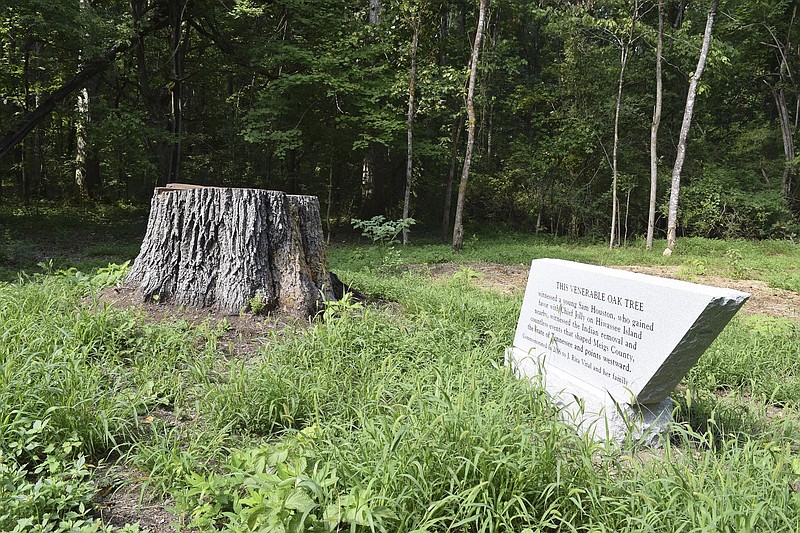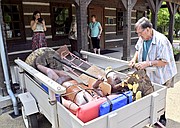Fast facts
The Cherokee Removal Memorial is dedicated to those Cherokees who died and those who cried in what has become known as the Trail of Tears. The names of the heads of the 2,537 households and the number of family members from the 1835 Census taken in preparation for the removal are inscribed on panels arranged by the state of their residence. Panels representing the seven Cherokee clans are superimposed on central part of the Cherokee Nation seal.Source: Cherokee Removal Memorial Park
BIRCHWOOD, Tenn. - When Cherokee leader Major Ridge signed the infamous 1835 Treaty of Echota that launched the Cherokee on the Trail of Tears, he was quoted as saying, "I have just signed my own death warrant."
Among the angry Cherokee who were ordered in June 1839 to execute him and others for the betrayal of his people was a man named Joseph Spears. He was the son of John Spears, a Cherokee interpreter appointed by Gen. Andrew Jackson to serve Return Jonathan Meigs, the Cherokee agent. Meigs County was named for Return Meigs.
The Spears men played a vital role in the history of the Cherokee and the tragedy of the Trail of Tears, according to local historians.
On Thursday, John Spears' fourth granddaughter Shirley Hoskins, a member of the Cherokee Nation in Oklahoma, delivered a sculpted wood representation of her ancestor to the Cherokee Removal Memorial Park in Meigs County at the confluence of the Tennessee and Hiwassee rivers. Hoskins was one of the visionaries who sought to establish the park in Meigs County.
The wood - carved in the early 1990s with a chainsaw and rasp by her now-85-year-old husband, Ray - came from a tulip poplar that fell into the couple's lake when they lived in the Agency Creek area of Meigs County. The couple hauled the sculpture and a bald eagle piece made from the same tree from their Atlanta home.
A Cherokee born in Oklahoma, Shirley Hoskins, 80, said she didn't know about her East Tennessee ancestry until she returned in 1965 to buy part of the 640 acres given to John Spears in the Treaty of 1817. Much of the site now is part of the Lakehaven subdivision.
"It was John Spears' reservation where we were living. Part of the treaty was that you had to live on the land," she said after the sculpture was carried inside the museum in Birchwood, Tenn.
"He was appointed Cherokee interpreter at Horseshoe Bend in 1817 when they moved the agency to Agency Creek," she said. John Spears served as interpreter until he died in 1828, she said.
The role of the Spears men is part of local history that is emerging with persistent research, according to Joy Montgomery, with the Texas Center for Regional Studies office in Dayton, Tenn. Shirley Hoskins' ancestors represent "a long line of history of adventurers" who dealt with the British, French and Spanish pressing westward through Indian territory, Montgomery said.
John Spears' son, Joseph, and thousands of his fellow Cherokee were forced to leave their tribal lands by the 1835 Treaty of Echota, even though it was roundly rejected by the newly formed Cherokee government, Montgomery said. Cherokees adamantly opposed removal and passed a death penalty law for anyone entering into an agreement ceding Cherokee land without approval of the Cherokee National Council.
A small group of treaty supporters, including Major Ridge, accepted compensation for their land and moved west on their own.
But Chief John Ross, a historic figure in Chattanooga and across the region, denied any involvement in the treaty, and more than 90 percent of the Cherokee people signed a petition to Congress rejecting the treaty and refusing to leave their homeland.
The petition was ignored. On May 24, 1838, the brutal roundup of the Cherokees began.
When they arrived in Indian Territory, old animosities re-emerged with other factions of the tribe. Joseph Spears was among those given the fateful order to execute the treaty signers: John Ridge, his son, Major Ridge, and Elias Boudinot, John Ridge's nephew and the first editor of the Cherokee Phoenix newspaper.
The trio were killed on June 22, 1839.
"Joseph Spears stabbed [John Ridge] in the heart in front of his screaming wife and children," Montgomery said. "It is ironic that earlier, Major Ridge had said there should be a death for anyone selling land to the white man."
Major Ridge had been appointed executioner in 1807 for a chief who had ceded land to whites.
Chief John Ross denied any involvement and a few weeks later both tribal governments entered into a general amnesty forgiving all previous transgressions. In September 1839 the governments were united with John Ross as the principal chief. The Army refused to recognize Ross and did not pay money due for the removal, leaving the Cherokee Nation in turmoil.
For the Cherokee, John Spears represents the Cherokee resilience in the struggle to remain one people as inside and outside forces pulled at them, said Greg Vital, longtime supporter and member of the Friends of Cherokee Removal Memorial Park.
"It all fits together like a puzzle that we keep unraveling," Vital said. "It's all part of the fabric of stories that are told here."
Contact staff writer Ben Benton at bbenton@timesfreepress.com or 423-757-6569.

